Air Rifles –Showing Increasing Mettle in the Big Game World While Proving Indispensable in Small Predator and Nuisance Species Control, Such As Knocking Out Invasive Iguanas
By Ken Perrotte – for The Hunting Wire

The four-foot iguana was hard to spot near the top of the palm tree. His lengthy striped tail gave him away. Ideally camouflaged, the lizards hold motionless, obviously aware of your approach. In a way, looking for iguanas tucked into the various tropical trees and shrubs of South Florida is like looking for wary squirrels or white-tailed deer tucked into cover. You often don’t spot the whole deer or squirrel, just a part of it.
Iguanas spook easily, seemingly able to differentiate between people who are stalking them versus casually ignoring them. They usually roost – if that’s an appropriate term – in trees, like turkeys, often on limbs close to or overhanging water. Get them too nervous in the trees and the next thing you hear is a big splash as they high dive into the protective waters of a canal or pond below them
This one chose to hold tight, right up until a .22 pellet from a Gamo Swarm magnum air rifle quicky finished him with a solid “thwack.”
Hunting iguanas in the trees requires a bit of spot and stalk savvy, especially on cooler days when the lizards prefer hanging in the trees and not lounging on the ground in the open sun. The iguanas on the ground are still wary and sprint toward the water like little dinosaurs in Jurassic Park if they think you’re a threat. Even the big males move surprisingly fast.
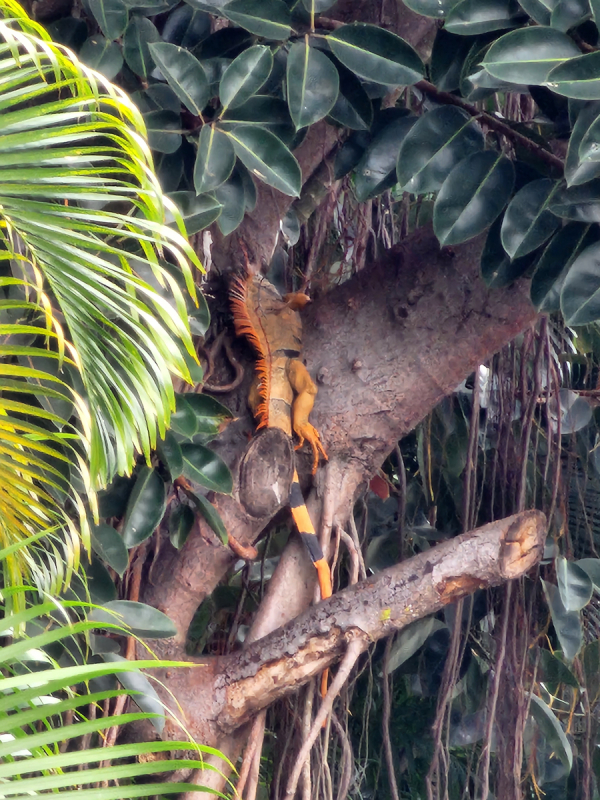
“Next time you’re here, I’m going to teach you ‘the walk.’ That’s the best way to get in close to those big boys,’” declares Harold Rondan, as he slings his Gamo Swarm Bone Collector .22 rifle over his shoulder and casually eases down a paved walking and riding path fronting a canal and greenspace favored by weekend picknickers and anglers. Just to his right, a four-lane boulevard is busy with Sunday afternoon traffic.
Iguanas of all sizes are overrunning southern Florida. They are everywhere, from cities to suburbs, parks to playgrounds.
The infestation likely came from the exotic species “aquarium trade” that flourished over the last 50 years. People thinking it would be cool to own a lizard later found out their pets grew to several feet long, Rondan says. It was more than they wanted to manage, so thinking they were doing the humane thing, they released the pet iguanas.
Maybe it was a favor for the individual iguanas, but for the rest of society it turned into a scourge with the Florida Fish and Wildlife Commission introducing new guidelines in April 2021 that classify the green iguana as a prohibited species. People can humanely kill them anywhere in the state.
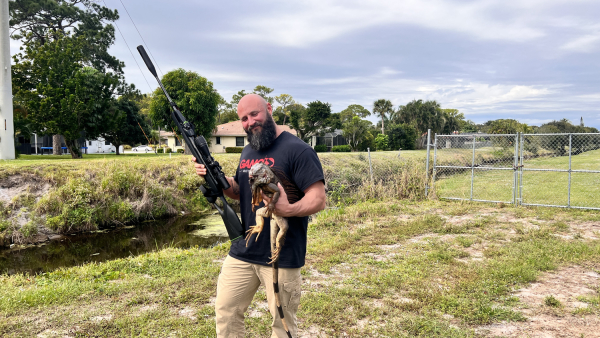
In a sense, they are like the worst plague of groundhogs, vegetation-eating deer, and scat depositing and water-contaminating geese. Iguanas are attracted to trees with foliage, flowers, most fruits (except citrus) and almost any vegetable. Where large populations exist, they damage infrastructure by digging burrows that erode and collapse sidewalks, foundations, seawalls, berms and canal banks. Their droppings contaminate docks, moored boats, seawalls, porches, decks, pool platforms and inside swimming pools.
Floridians are no longer allowed to get them as pets. People with green iguanas as personal pets before April 29, 2021, can apply for a free Prohibited Species for Personal Use permit to maintain that pet for the rest of its life, but the iguanas must be marked with a passive integrated transponder tag.
Iguana hunters can take the lizards from public lands managed by the FWC without a permit. Iguanas must be killed before moving them. Live transport is prohibited. The FWC also encourages private properties to remove green iguanas.
Rondan, known as the “Iguana Guy” around southern Florida, saw business potential in this burgeoning problem. He created Iguana Lifestyles LLC. His company specializes in removing invasive species, especially iguanas. Rondan contracts with many homeowner associations and municipalities and has even been called when homeowners lift the lid on their toilet seat and find an iguana in the bowl. He estimates he’s killed some 10,000 iguanas since starting his business.
While some clients request trapping or snaring with a catch pole as the primary tools for iguana control, Rondan believes high-powered air rifles shooting pellets are easily the most efficient and effective means to taking out the reptiles.
Back to ‘The Walk’
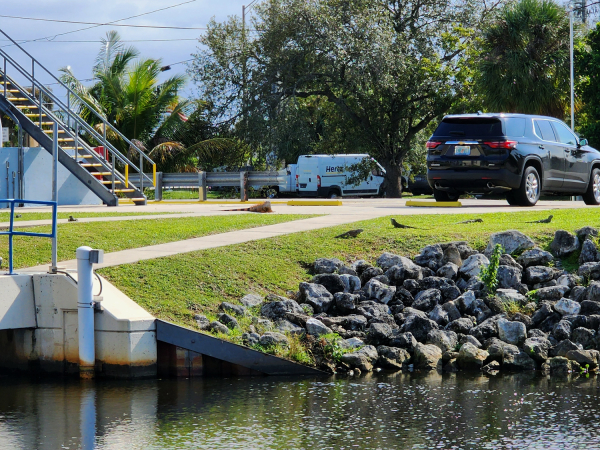
The lizards are pervasive, seemingly everywhere on sunny, warm days. Shooting them in settings where they are habituated to humans and vehicles is more challenging than it can appear.
First, their brain is about the size of an aspirin. Body shots won’t deliver a humane death. You need to tuck that pellet into the area between the lizard’s eye and ear for it to immediately drop. This requires practiced skill with whatever air rifle you employ. You also need to understand the pellet ballistics relative to the rifle you’re using. For example, the lead, plastic-tipped hunting pellets fired from the Game Swarm Bone Collector Gen3i rifle zeroed at 30 yards drop a little after leaving the muzzle. So, if your target is 10-15 yards away, you must hold a little high, otherwise you’re kicking up dirt under the iguana’s chin or zinging rounds into the limbs or leaves where they are hiding. Knowing where pellets hit at varying distances is essential.
Next, since you’re walking around suburban and urban areas carrying rifles, albeit pellet rifles, motorists and homeowners don’t know this. A detailed phone call with local law enforcement authorities is vital because once you’re strolling with that rifle, the 911 calls are going to come in.
Finally, successful iguana hunting in these environments requires a little acting.
“Those iguanas are used to seeing people all day. Mostly, the people ignore them, acting like they aren’t even there. We need to do that when we’re carrying a rifle,” explains Rondan
Rondan and I walk along a paved path, edging closer toward a medium-sized male iguana lounging close to the water’s edge.
“Don’t slow down. Don’t look at him or make eye contact. We’re walking nice and normal, nothing to see here,” Rondan says. As we pass a streetlight pole that serves as a partial screen with the iguana just 10 yards away, he taps me on the shoulder and instructs, “Lean in here and take the shot, right behind the eye. We’re in close so hold just over the top of its head because the way the rifle is sighted, the pellet will start out lower.”
I take a breath, push the safety forward and squeeze the trigger. Smack! The iguana flips, landing dead with nerves twitching at the edge of the water.
Rondan and I bag another 25 before calling it an afternoon. In the previous two days, chasing iguanas in cool, rainy, more challenging weather with Gamo’s Lawrence Taylor and Tony Stratis, Angie Perry (Airgun Angie) and Rick Eutsler of AirgunwebTV, we collected at least another 25-30. We didn’t dent the population.
How Big?

Iguanas can grow long - six feet or better – and sport a long, whiplike, horizontally striped tail that makes up about half that body length. The tail can rip off when fighting or detach when the iguana is trapped. It regrows, albeit without the striping that characterizes the original growth.
While most female and younger green iguanas remain green, larger males, engaged in a relentless late fall and early winter rut, unlike white-tailed deer, can turn brown/bronze or a vivid orange. The big ones, often glowingly bright, are easy to spot.
In one water control structure along a canal just north of Miami, we spotted more than 20 iguanas. The largest was better than six feet long. He was soaking up the sun, stationed in a parking lot close to a harem of females and a Ford F-150. When agitated, he lifted his head repeatedly, flapping his saggy dewlap. Male iguanas do this in response to territorial threats and to display for females. The males’ femoral pores, located along the bottom of their rear legs cover glands that secrete markers giving information to other iguanas.
Iguanas dig intersecting tunnels sometimes 80 feet long, undermining canal banks, flood control areas, bridges and more. Females can lay anywhere from a dozen to 80 or so eggs, depending on their size. Bouncing little baby iguanas where thick in some places we worked. Too hard to spot and shoot, they represent the next wave of the infestation. Control is the best humans can hope for at this stage.
Noting the approaching Florida cold snap, some friends joked, “Why shoot them? Just wait for the cold and then pick them up when they fall from the trees.” That’s a clever idea, but the thing is the cold doesn’t kill them unless it is prolonged, reportedly four days or better. They go into some suspended animation. Also, Rondan says he believes iguanas are learning to adapt. Instead of trying to ride out the cold in the trees, many retreat to their warmer subterranean tunnels.
How Do They Taste?
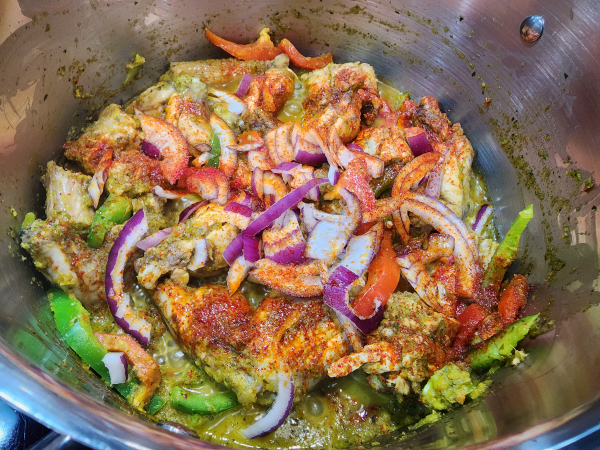
“Green iguanas were originally bred as a food species in Central America,” Rondan explains. Iguanas are occasionally referred to as "chicken of the trees." With a little culinary skill, you can transform them into some flavorful dishes, especially those that emphasize braising and Latin American spices. For a detailed cleaning and cooking video, see www.outdoorsrambler.com.
The Guns and Gear
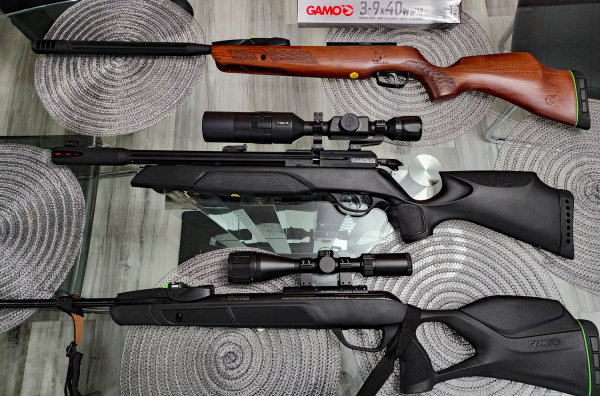
Our hunting party used three different, new for 2022 Gamo precision adult air rifles on our expedition. The rifle is ideal for pest-control applications in urban/suburban settings because the shot is suppressed. Sub-sonic velocities are exceptionally quiet. We used Gamo’s “Red Fire” lead pellets, which weigh 114 grains and sport a diamond-shaped, hard polymer tip. The pellets, utterly lethal at close, intended ranges, rapidly lose steam downrange, minimizing the chance for any unintended damage, although iguana professionals always practice the basic tenets of firearms safety, including knowing their target and beyond. Understanding the ballistics of the various rifle/pellet combinations, though, sometimes enables shots one would never entertain with a rimfire or centerfire rifle.
The Swarm Magnum 10X GEN3i .22 caliber
This inertia-fed, break-action model features Gamo’s latest generation design, including a 10-shot, patent-pending Quick-Shot magazine that loads a pellet each time the rifle is cocked. The magazine indexes using the inertia force from the recoil of the air rifle. The rifle is potent, with its IGT Mach 1 33mm cylinder power plant delivering a velocity of up to 1,300 feet per second with .22 caliber lightweight alloy pellets. The lead “Red Fire” hunting pellets we used launched at about 1,000 feet per second.
Cocking the rifle takes a bit of effort. It requires 41 pounds of pressure to break open the action and get it ready to fire. It may be too robust for people lacking leverage and arm strength. The payoff is increased lethality downrange.
The Swarm Magnum is the optimum choice for small game species such as rabbits, squirrels, raccoons, crows and iguanas out to about 70 yards. Every Swarm Magnum 10x GEN3i .22 air rifle includes a Gamo 3-9×40 scope (with a one-piece mount).
Other specifications:
Swarm Bone Collector 10X GEN3i. .22 caliber
The Swarm Bone Collector 10X GEN3i Inertia was designed in collaboration with Michael Waddell and Travis “T Bone” Turner of the “BONE COLLECTOR” TV series. It features the brand logo on the fine beechwood stock. Like the Swarm Magnum, it employs the 10-pellet Quick-Shot rotary magazine.
This rifle can achieve up to 1,100 feet per second at the muzzle with alloy pellets. Our lead hunting rounds that delivered more kinetic energy fired at about 800 fps.
The rifle cocks with 31 pounds of pressure. Although just 10 pounds easier than the magnum, this difference was highly perceptible. It was my favorite option during the hunt.
Other Specifications:
This compact (39 inches) rifle is ideal for hunting and pest control, capable of firing up to 60 pellets without reload. It is a PCP (pre-charged pneumatic) gun powered up with a compressor that fills an internal tank. It has an advertised 900 feet per second capability using alloy pellets, but our more potent lead hunting pellets were traveling at about 500 fps. It has multi-shot capability and uses the 10X Quick-Shot technology. You load a round by pulling back and releasing a short charging handle, not unlike some AR platforms.
Other specifications: